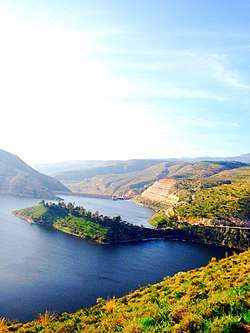Jordan Trail
| Jordan Trail | |
|---|---|
 The King Talal Dam in Jerash lies along the Jordan Trail. | |
| Length | 650 km (400 mi) |
| Location | Jordan |
| Established | 2015 |
| Trailheads |
Umm Qais Aqaba |
| Use | Hiking |
| Elevation | |
| Elevation change | 1,730 m (5,676 ft) |
| Highest point | Wadi Rum, 1,300 m (4,265 ft) (highest point in Jordan) |
| Lowest point | Dead Sea, −430 m (−1,411 ft) (lowest point on earth) |
| Hiking details | |
| Months | Early March to Late September |
| Sights | Petra, Jerash |
| Website | jordantrail.org |
Jordan Trail is a 650 km (400 mi) long trail in Jordan. Established in 2015 by the Jordan Trail Association, which aims to revive Jordan's tourism sector after having faced setbacks in early 2010s.
The trail stretches from Umm Qais in northern Jordan to the coastal city of Aqaba in its south. The trail passes through 52 villages and towns, but the trail has been dissected to 35 sections. The entire length of the trail takes around 40 days to complete.
The trail received extensive media coverage after its inception, and has been named as among 2018's best tourist destinations in the world to visit by National Geographic,[1] the British Sunday Times, the Guardian, Condenast, Vogue US and Lonely Planet.[2]
History
The oldest trail in Jordan was an ancient trade route that is known today as the "King's Highway", which spanned from Egypt to Syria passing by Jordan.[3] Moses, Jesus and Muhammad are believed to have walked along what is now the Jordan Trail.[1]
The idea of a hiking trail stretching across Jordan was first introduced in the 1990s when Wadi Rum became to be seen as a hot spot for rock climbing.[4] The idea only received momentum and funding when the Jordan Trail Association was established in 2015.[4] Volunteers and donors from the private sector contributed to the development of Jordan's first national hiking trail.[3] Queen Rania joined a group of travel bloggers in 2017 for a short hike.[4]
The Trail

The trail has been described as the "Inca Trail of the Middle East" by numerous travel agencies. The trail will be beneficial to Jordan's tourism sector as it begins to recover from the slump it witnessed due to regional turmoil in the early 2010s from the Arab Spring.[5]
The trail stretches from Umm Qais in northern Jordan to the coastal city of Aqaba in its south. The 650 km (400 mi) trail takes around 40 days to complete.[3] It passes through 52 villages and towns, and through Jordan's most popular tourist attractions ranging from ancient Greco-Roman cities to Medieval Islamic castles.[6] The trail received extensive media coverage after its inception, and has been named as among 2018's best tourist destinations in the world by National Geographic, the British Sunday Times, the Guardian, Condenast, Vogue US and Lonely Planet.[2]
References
- 1 2 Duckett, Maryellen, Kennedy. "Places You Need to Visit in 2018", National Geographic. Accessed March 20, 2018. "The Jordan Trail highlights the country’s most scenic sites.... It’s believed that Jesus, Moses, and Mohammed all walked this path."
- 1 2 "Registration for Jordan Trail's Thru-Hike opens". The Jordan Times. 17 February 2018. Retrieved 12 March 2018.
- 1 2 3 "About Jordan Trail". jordantrail.org. 1 January 2017. Retrieved 13 March 2018.
- 1 2 3 "Walking through history on the spectacular Jordan Trail". The Daily Telegraph. 27 November 2017. Retrieved 13 March 2018.
- ↑ "Petra, Jordan Trail among 2018's best global destinations". The Jordan Times. 18 December 2017. Retrieved 13 March 2018.
- ↑ "Jordan Trail: 400-mile hiking route rebooting Middle East tourism". The Independent. 6 April 2017. Retrieved 13 March 2018.